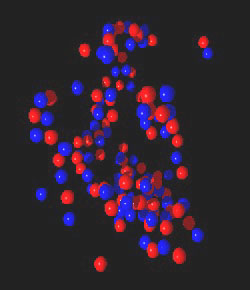Faster Crunching with Field Lines

A new method for simulating the interactions of charged particles could eventually make it easier to custom design drugs. The technique, reported in the 13 May print issue of PRL along with results from a simple test, involves treating the electric force as a local disturbance instead of a tug between far-flung atoms. Simulations based on this approach could be well suited for many computers working in parallel–one way of speeding up such calculations.
Existing schemes for computing the electric force felt by a single particle require repeatedly adding up the contributions from its neighbors near and far. Only one kind of simulation technique–called molecular dynamics–can handle these calculations with any speed. Molecular dynamics programs find the force on a particle by solving Newton’s second law over and over. The alternative Monte Carlo (MC) method, which is superior for certain applications, simulates particle motion by calculating the energy change when a particle is moved. If the energy goes down, the move is appproved; if it goes up, the move is rejected or approved randomly. Unfortunately, MC has no fast methods for modeling charged systems, says Anthony Maggs of the College of Industrial Physics and Chemistry (ESPCI) in Paris.
“The problem is you’re doing [the calculations] in a way that nature does not,” Maggs says. Nature has Gauss’s law, he points out, which describes an electric field in terms of lines of force, or flux, that bend and wiggle. You can see the idea in the paths that iron filings trace out near a magnet. So Maggs cast the energy of a system of charged particles in terms of flux lines and turned this description into MC code. “Paradoxically, you’d think that would create more work,” he says, but he and a student found otherwise when they ran a rudimentary Monte Carlo simulation of scattered charged particles. The state of this gas could be updated in a time proportional to the number of particles, which was at least as fast as some more complicated methods using molecular dynamics.
Maggs says his goal is just to show the system’s advantages and then let the “professionals” take over. In particular, he expects it to benefit rational drug design, where researchers model biological molecules to guide the creation of more effective pharmaceuticals. Such studies will probably rely on molecular dynamics, so he is working on a way to transfer the technique. As an added benefit, he says, the scheme could make it easier for individual researchers to take on complex simulations.
“This is a very original idea,” says Massimo Marchi of the French Commission for Atomic Energy (CEA) in Saclay. Extending it to molecular dynamics would be valuable, he says, but may also be difficult. Erik Luijten of the University of Illinois at Urbana-Champaign says the local character of the new technique should lower the time that parallel computers must spend talking to each other, because moving a single particle would affect only its immediate neighbors. He and others caution that technical hurdles may remain, though: “The crucial test will be to see how the algorithm performs in a real-life example.”
–JR Minkel
JR Minkel is a freelance science writer in New York City.


